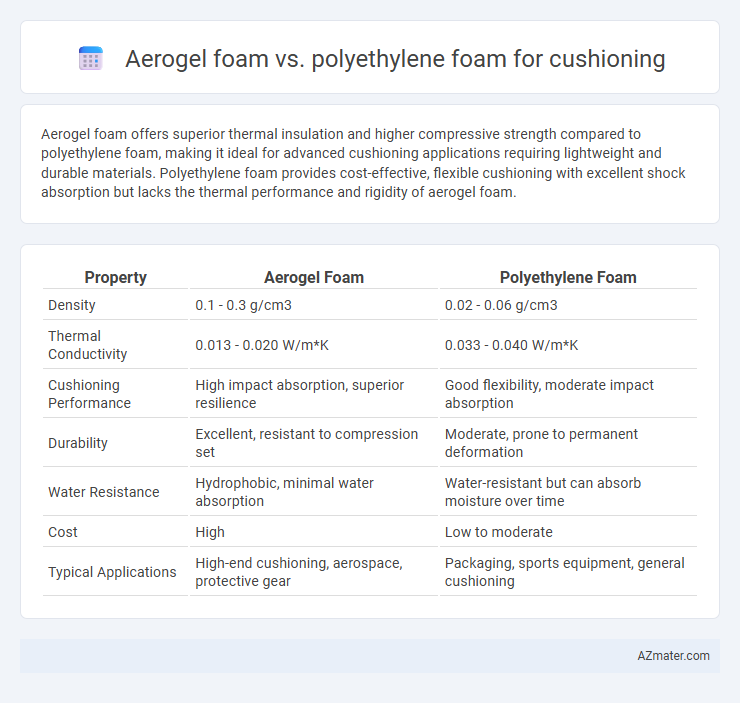Aerogel foam offers superior thermal insulation and higher compressive strength compared to polyethylene foam, making it ideal for advanced cushioning applications requiring lightweight and durable materials. Polyethylene foam provides cost-effective, flexible cushioning with excellent shock absorption but lacks the thermal performance and rigidity of aerogel foam.
Table of Comparison
| Property | Aerogel Foam | Polyethylene Foam |
|---|---|---|
| Density | 0.1 - 0.3 g/cm3 | 0.02 - 0.06 g/cm3 |
| Thermal Conductivity | 0.013 - 0.020 W/m*K | 0.033 - 0.040 W/m*K |
| Cushioning Performance | High impact absorption, superior resilience | Good flexibility, moderate impact absorption |
| Durability | Excellent, resistant to compression set | Moderate, prone to permanent deformation |
| Water Resistance | Hydrophobic, minimal water absorption | Water-resistant but can absorb moisture over time |
| Cost | High | Low to moderate |
| Typical Applications | High-end cushioning, aerospace, protective gear | Packaging, sports equipment, general cushioning |
Introduction to Cushioning Materials
Aerogel foam and polyethylene foam are widely utilized cushioning materials known for their unique properties; aerogel foam offers exceptional thermal insulation and lightweight structure due to its nanoporous silica composition, while polyethylene foam provides durable shock absorption and flexibility with its closed-cell polymer structure. Aerogel foam's high compressive strength and low density make it ideal for applications requiring minimal bulk and maximum insulation performance, whereas polyethylene foam excels in providing resilient cushioning in packaging and sports equipment through its impact resistance and moisture-impermeability. The choice between aerogel and polyethylene foam ultimately depends on specific cushioning needs such as thermal insulation versus mechanical shock protection.
What is Aerogel Foam?
Aerogel foam is an ultra-lightweight, porous material composed of a silica-based network filled with air, offering exceptional thermal insulation and high compressive strength. Unlike polyethylene foam, aerogel foam provides superior cushioning due to its unique nanostructure, which allows it to absorb impact effectively while maintaining minimal thickness. Its low density and excellent energy absorption properties make aerogel foam ideal for advanced cushioning applications in aerospace and electronics.
What is Polyethylene Foam?
Polyethylene foam is a closed-cell, lightweight cushioning material known for its excellent shock absorption, water resistance, and durability, making it ideal for packaging, insulation, and impact protection. Compared to aerogel foam, polyethylene foam offers greater flexibility and cost-effectiveness but has lower thermal insulation properties and compressive strength. In cushioning applications, polyethylene foam provides reliable protection against mechanical stresses, while aerogel foam excels in thermal insulation and lightweight performance.
Key Properties: Aerogel Foam vs Polyethylene Foam
Aerogel foam offers exceptional thermal insulation and ultra-lightweight cushioning with high compressive strength, making it ideal for advanced protective applications. Polyethylene foam provides durable impact absorption, moisture resistance, and cost-effective cushioning commonly used in packaging and sports equipment. Aerogel excels in thermal and lightweight properties, while polyethylene stands out for its toughness and environmental resistance.
Cushioning Performance Comparison
Aerogel foam provides superior cushioning performance due to its ultra-low density and high energy absorption capacity, making it ideal for impact protection in sensitive applications. Polyethylene foam offers effective cushioning with good resilience and durability but has a higher density and lower compressive strength compared to aerogel foam. The thermal insulation and vibration dampening properties of aerogel foam further enhance its cushioning efficiency over polyethylene foam in advanced packaging and protective gear.
Thermal and Acoustic Insulation Differences
Aerogel foam outperforms polyethylene foam in thermal insulation due to its ultra-low thermal conductivity, often below 0.02 W/m*K, making it ideal for extreme temperature control applications. In acoustic insulation, polyethylene foam provides better sound absorption and noise reduction, benefiting environments requiring impact and vibration damping. While aerogel foam excels in minimizing heat transfer, polyethylene foam remains more effective for general-purpose cushioning with enhanced acoustic attenuation.
Durability and Longevity Factors
Aerogel foam exhibits superior durability and longevity compared to polyethylene foam due to its rigid nanostructure and high resistance to compression set, making it ideal for long-term cushioning applications. Polyethylene foam tends to degrade faster under repeated mechanical stress and environmental exposure, resulting in diminished cushioning performance over time. The superior thermal stability and moisture resistance of aerogel foam further extend its operational lifespan in demanding cushioning environments.
Environmental Impact and Sustainability
Aerogel foam exhibits superior thermal insulation with minimal environmental footprint due to its low density and high recyclability, making it a sustainable choice for cushioning applications. Polyethylene foam, while widely used for cushioning, poses challenges in biodegradability and contributes to plastic pollution due to its petroleum-based composition and limited recycling options. Choosing aerogel foam over polyethylene foam significantly reduces environmental impact, supporting eco-friendly product life cycles and sustainable packaging initiatives.
Applications in Packaging and Protective Gear
Aerogel foam offers superior thermal insulation and impact resistance, making it ideal for high-performance packaging and protective gear that requires lightweight yet durable cushioning. Polyethylene foam provides cost-effective, flexible, and moisture-resistant cushioning widely used for fragile item packaging and sports protective padding. The choice depends on specific application demands, with aerogel foam favored for extreme protection and lightweight needs, while polyethylene foam suits general cushioning and affordability.
Cost Analysis and Practical Considerations
Aerogel foam offers superior thermal insulation and lightweight properties but comes with significantly higher costs, ranging from $20 to $50 per cubic foot, compared to polyethylene foam's $1 to $5 per cubic foot. Polyethylene foam provides durable cushioning suitable for packaging and impact absorption at a fraction of the price, making it the preferred choice for cost-sensitive applications. Practical considerations include aerogel's brittleness and processing difficulties versus polyethylene's flexibility and ease of manufacturing, impacting long-term performance and application versatility.

Infographic: Aerogel foam vs Polyethylene foam for Cushioning
 azmater.com
azmater.com